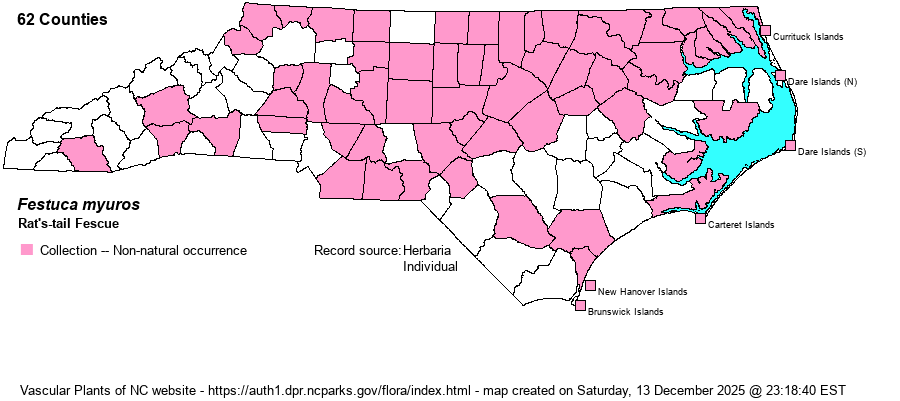| Author | L. | |
| Distribution | Mostly the Sandhills, Piedmont, Outer Banks, other barrier islands, and the northern Coastal Plain; sporadic in the Mountains. Gaps in the Coastal Plain surely will be filled over time.
Native to Europe and North Africa; in N.A. mostly in the eastern, southern, and western states. | |
| Abundance | Frequent to common in most regions, except uncommon to rare in the Mountains. | |
| Habitat | Dry to xeric sandy soils of roadsides, fields, clearings, maritime dry grasslands, waste ground, etc. | |
| Phenology | Flowering and fruiting April-June. | |
| Identification | Rat's-tail Fescue grows 2 feet or less tall, often less than a foot. The inflorescence occupies the upper half or so of the stem and is spikelike, with 1 spikelet per node. The spikelets have 3-7 florets each. F. bromoides is very similar, but differs in its lower glume more than 1/2 the length of the upper glume (vs. less than 1/2 the length in F. bromoides). The native F. sciurea has smaller spikelets (3.5-5.2 mm long vs. 5-12 mm long in F. myuros). | |
| Taxonomic Comments | Synonyms include Vulpia myuros.
Bromus, Festuca, and Poa all can look quite similar to beginners (and even veterans!), because they all have multi-flowered spikelets. Generally speaking, Bromus has much the largest spikelets, and most Poa have a tuft of wispy hairs at the base of each floret (lacking in the other genera). Bromus and Festuca have obvious awns on the florets (absent in Poa). With field experience and careful use of keys, one can eventually handle these genera.
Our annual species of Festuca are by some authors placed in the genus Vulpia; they have a single stamen (vs. perennial and with 3 stamens). | |
| Other Common Name(s) | | |
| State Rank | SE | |
| Global Rank | G5 | |
| State Status | | |
| US Status | | |
| USACE-agcp | | |
| USACE-emp | | |

